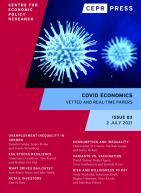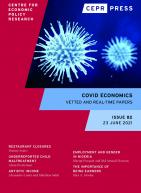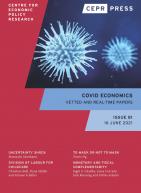
Japan's government has taken a number of measures, including declaring a state of emergency, to combat the spread COVID-19. We examine the mechanisms through which the government's policies have led to changes in people's behavior. Using smartphone location data, we construct a daily prefecture-level stay-at-home measure to identify the following two effects: (1) the effect that citizens refrained from going out in line with the government's request, and (2) the effect that government announcements reinforced awareness with regard to the seriousness of the pandemic and people voluntarily refrained from going out. Our main findings are as follows. First, the declaration of the state of emergency reduced the number of people leaving their homes by 8.6% through the first channel, which is of the same order of magnitude as the estimate by Goolsbee and Syverson (2020) for lockdowns in the United States. Second, a 1% increase in new infections in a prefecture reduces people's outings in that prefecture by 0.026%. Third, the government's requests are responsible for about one quarter of the decrease in outings in Tokyo, while the remaining three quarters are the result of information updating on the part of citizens through government announcements and the daily release of the number of infections. Our results suggest that what is necessary to contain the spread of COVID-19 is not strong, legally binding measures but the provision of appropriate information that encourages people to change their behavior.
Citation
Yabu, T and T Watanabe (2020), ‘Japan's Voluntary Lockdown‘, COVID Economics 46, CEPR Press, Paris & London. https://cepr.org/publications/covid-economics-issue-46#392514_392922_390604
We use microsimulation to estimate the distributional consequences of covid-19-induced lockdown policies in Argentina, Brazil, Colombia and Mexico. Our estimates of the poverty consequences are worse than many others’ projections because we do not assume that the income losses are proportionally equal across the income distribution. We also simulate the effects of most of the expanded social assistance governments have introduced in response to the crisis. This has a large offsetting effect in Brazil and Argentina, much less in Colombia. In Mexico, there has been no such expansion. Contrary to prior expectations, we find that the worst effects are not on the poorest, but those (roughly) in the middle of the ex ante income distribution. In Brazil we find that poverty among the afrodescendants and indigenous populations increases by more than for whites, but the offsetting effects of expanded social assistance also are larger for the former. In Mexico, the crisis induces significantly less poverty among the indigenous population than it does for the nonindigenous one. In all countries the increase in poverty induced by the lockdown is similar for male- and female-headed households but the offsetting effect of expanded social assistance is greater for female-headed households.
Citation
Youngerue, S, V Pabon, F Sanz and N Lustig (2020), ‘The Impact of COVID-19 Lockdowns and Expanded Social Assistance on Inequality, Poverty and Mobility in Argentina, Social Assistance‘, COVID Economics 46, CEPR Press, Paris & London. https://cepr.org/publications/covid-economics-issue-46#392514_392922_390606
Using data collected from one of the most popular ridesharing platforms, we illustrate how mobility has changed after the exit from the Covid-19 induced confinement. We measure the impact of the Covid-19 outbreak on the level of mobility and the price of ridesharing. Finally, we show that the pandemic has exacerbated ethnic discrimination. Our results suggest that a decision-maker encouraging the use of ridesharing during the pandemic should account for the impact of the perceived health risks on ridesharing prices and should find ways to ensure fair access.
Citation
Palikot, E and M Ivaldi (2020), ‘Sharing when stranger equals danger:Ridesharing during Covid-19 pandemic‘, COVID Economics 46, CEPR Press, Paris & London. https://cepr.org/publications/covid-economics-issue-46#392514_392922_390607
There is a concern among social scientists and policymakers that the COVID-19 crisis might permanently change the nature of work. We study how labor demand in Mexico has been affected during the pandemic by web scraping job ads from a leading job search website. As in the U.S., the number of vacancies in Mexico declined sharply during the lockdown (38 percent). In April there was a change in the composition of labor demand, and wages dropped across the board. By May, however, the wage distribution and the distribution of job ads by occupation returned to their pre-pandemic levels. Overall, there was a slight decline in specific requirements (gender and age), no change in required experience, and a temporary increase in demand for low-skilled workers. Contrary to expectations, opportunities for telecommuting diminished during the pandemic. Using a simple Oaxaca-Blinder decomposition, we find that the variation in the average advertised wage in April is explained more by a higher proportion of low-wage occupations than by a reduction in the wages paid for particular occupations. In sum, we find no evidence of a significant or permanent change in labor demand during the pandemic in Mexico.
Citation
Campos-Vazquez, R, G Esquivel and R Badillo (2020), ‘How Has Labor Demand Been Affected by the COVID-19 Pandemic? Evidence from Job Ads in Mexico‘, COVID Economics 46, CEPR Press, Paris & London. https://cepr.org/publications/covid-economics-issue-46#392514_392922_390608
We use the Current Employment Statistics Survey microdata to calculate employment changes since February 2020 by employer size. We find that for employers with 1-9 employees, the largest component of employment change since February is due to closings in all months (either temporary or permanent). For 10 or more employees by April, the largest component of employment change since February is employment changes within continuing employers, rather than those reporting zero employment or imputed closures from non-respondents in the survey. In percentage terms, the greatest overall employment losses shifted to larger and larger employers each month. By July, the largest cumulative employment losses were for employers with 100-499 employees, with 8% loss in employment since February, while employers with 1-9 employees had a loss of 4.3% in employment since February.
Citation
Loewenstein, M, E Weber Handwerker and M Dalton (2020), ‘Employment Changes by Employer Size using the Current Employment Statistics Survey microdata during the COVID-19 pandemic‘, COVID Economics 46, CEPR Press, Paris & London. https://cepr.org/publications/covid-economics-issue-46#392514_392922_390609
Recent years have witnessed a surge in demand from investors who invest with a socially responsible mandate. We study stock returns associated with this practice in the COVID-19 crash and the months before it. Based on data on mutual funds, we find that stocks with greater socially conscious investor ownership experience superior returns, lower returns volatility, and better market valuations during the pandemic. No differences are to be found with respect to gross profitability, operating income, and sales growth as well as expectations about the long-term growth rate of earnings per share. This suggests that socially conscious investors can act as a moderating force by mitigating losses in the stock market in a time of crisis.
Citation
Yang, R and I Koci (2020), ‘Socially Conscious Investors: Mitigating Stock Market Losses During the COVID-19 Crash‘, COVID Economics 46, CEPR Press, Paris & London. https://cepr.org/publications/covid-economics-issue-46#392514_392922_390610


Covid Economics - Issue 82
- Restaurant Closures during the Pandemic: A Descriptive Analysis
- Underreporting Child Maltreatment during the Pandemic: Evidence from Colorado
- Covid-19 impact on Artistic Income
- COVID-19, Employment, and Gender: Evidence from Nigeria
- The Importance of Being Earners: Modelling the Implications of Changes to Welfare Contributions on Macroeconomic Recovery
